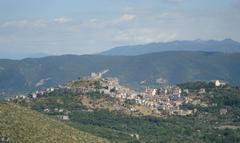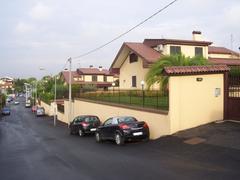Roman Villa of the Tor Mastorta Estate: Visiting Hours, Tickets, and Historical Significance Guide
Date: 14/06/2025
Introduction
The Roman Villa of the Tor Mastorta Estate, set within the tranquil Parco Naturale Regionale dell’Inviolata near Guidonia Montecelio, invites visitors to step into the luxurious rural world of ancient Rome. This unique archaeological treasure, located just 12 miles north of the capital, offers an immersive experience where history, culture, and the serene landscape of the Roman countryside converge. The estate is not only significant for its Roman origins as a villa complex and agricultural hub but also for its layers of medieval and ecclesiastical history, visible in structures such as the ancient tower and historic farmsteads (casali storici) that rest on Roman foundations. These features, coupled with the estate’s protected natural setting, make Tor Mastorta a compelling site for history enthusiasts, nature lovers, and anyone seeking an engaging retreat from city life (LabGeoCaraci; Parco Naturale Regionale dei Monti Lucretili; Estateromana).
This guide provides essential information about visiting Tor Mastorta: opening hours, ticketing, accessibility, travel tips, and highlights of the villa’s archaeological and cultural significance. You’ll also discover details about nearby attractions, local traditions, gastronomy, and accommodation to help plan a rewarding and memorable journey.
Archaeological Context and Discovery
Tor Mastorta is situated in the northern Agro Romano, historically bordered by Sant’Angelo and Monticelli. Once called Tor Sabella under the Savelli family, it later passed to the canons of Sant’Antonio Abate and, by the time of Pope Pius VI, became property of the Accademia Ecclesiastica (LabGeoCaraci). A notable archaeological discovery in 1832 was the funerary inscription of Marcus Numio Proculus—a silk merchant—erected by his wife, Valeria Criside, demonstrating the estate’s role as a residence and burial site for affluent citizens.
Historical Significance of Roman Villas in the Region
Roman villas like Tor Mastorta were more than country retreats; they symbolized wealth, social status, and power. These estates functioned as productive agricultural centers, social venues, and peaceful getaways for the elite, strategically located near Rome for convenience and seclusion. The estate’s division into quarters and its documented land area reflect a complex, multifunctional organization typical of elite Roman villas (Odyssey Traveller).
Architectural Features and Estate Layout
Although extensive archaeological excavations at Tor Mastorta are limited, the estate likely mirrored the typical Roman luxury villa, which included:
- Residential Quarters: Private apartments with mosaic floors, frescoes, and marble decor.
- Reception and Dining Areas: Grand spaces for entertaining, such as triclinia and peristyles.
- Bath Complexes: Private baths with hypocaust heating systems.
- Gardens and Water Features: Landscaped gardens, fountains, and ornamental lakes—modern accounts mention two small lakes at the site (Roma-o-matic).
- Agricultural Facilities: Outbuildings for storage, processing, and worker accommodation (Odyssey Traveller).
Socio-Economic and Cultural Role
Elite Roman villas like Tor Mastorta were economic engines, employing workers and slaves to cultivate crops and manage livestock. The presence of the tomb of a silk merchant reflects the diversity of villa residents and their commercial connections. Beyond economics, these villas served as cultural hubs, hosting social, political, and intellectual gatherings (LabGeoCaraci).
Archaeological Evidence and Preservation
The funerary inscription of Marcus Numio Proculus is the principal archaeological find, shedding light on the social fabric of the estate’s residents. The estate’s preserved boundaries, rural landscape, and historical transformations—from noble to ecclesiastical ownership—exemplify the enduring patterns of land use and cultural continuity (LabGeoCaraci).
Visiting Tor Mastorta: Hours, Tickets, and Accessibility
- Opening Hours: The Parco dell’Inviolata and the Tor Mastorta Estate are typically open from 8:00 AM to sunset year-round. However, access to specific villa areas may be restricted due to restoration or private ownership. Always check the latest updates on the Parco Naturale Regionale dei Monti Lucretili website or local tourism offices.
- Tickets: Entry to the park is free. Guided tours or cultural events may require a fee and advance booking (Estateromana).
- Accessibility: The rural terrain includes unpaved paths and natural features that may pose challenges for those with mobility issues. There are currently no dedicated accessibility facilities; contact local guides or visitor centers for advice.
- Guided Tours: Periodic guided tours, often during special events or heritage days, provide access to otherwise restricted areas.
Site Layout, Walking Routes, and Visitor Facilities
The estate features villa ruins, the medieval Torre di Tor Mastorta, and rural farmhouses amid rolling hills and meadows. Popular trekking routes start from Via Formello and traverse fields and woodlands toward the villa. The terrain is mostly flat and suitable for families, though some paths can be muddy after rain (daromainviaggio.it). Facilities are minimal: bring water, snacks, and sun protection, and prepare for a rustic, natural experience.
Local Culture and Community Traditions
Guidonia Montecelio is steeped in rural traditions, blending agricultural heritage with metropolitan influences from Rome. The community celebrates harvest festivals, local saints, and historic milestones. The area’s industrial background in travertine and cement complements its rustic charm, offering visitors a multifaceted cultural experience (IlTerritorio.net; The Crazy Tourist).
Events, Restoration, and Heritage Initiatives
- Events: While Tor Mastorta itself does not regularly host events, Guidonia Montecelio organizes religious festivals, local fairs, and cultural exhibitions—check the Comune di Guidonia Montecelio for updates.
- Restoration: The Soprintendenza per l’archeologia coordinates ongoing restoration to preserve the estate’s archaeological value (IlTerritorio.net).
Gastronomy and Dining
Lazio’s cuisine is celebrated in Guidonia Montecelio’s restaurants and agriturismi. Enjoy specialties such as porchetta, cacio e pepe, and seasonal vegetables. Recommended dining options include Pizzico for fresh pizza and Sibilla Restaurant in Tivoli for panoramic views (Audiala; The Crazy Tourist). Agriturismi offer farm-to-table meals for an authentic rural experience.
Accommodation
Stay in comfort at nearby hotels, country resorts, or self-catering apartments:
- Hotels: Hotel Aurora Wellness & Spa, Hotel Tivoli, Grand Hotel Duca d’Este, Victoria Terme Hotel (Trip.com; Booking.com)
- Country Resorts: La Tenuta di Rocca Bruna, Carpediem Roma Golf Club
- Apartments: Flexible options, often with bike rentals and pet-friendly policies
Book early during peak seasons and notify hosts of any special needs.
Practical Tips
- Wear sturdy shoes and comfortable clothing.
- Bring water, snacks, and sun protection.
- Use maps or GPS as signage is minimal.
- Respect site rules—do not remove artifacts or disturb wildlife.
- For safety, carry a mobile phone and check local weather before your visit.
Frequently Asked Questions (FAQ)
Q: What are the current visiting hours for Tor Mastorta Estate?
A: The park is open from 8:00 AM to sunset, but villa access may be limited during restoration. Check official sources before your visit.
Q: Is there an entry fee?
A: Entry is free; guided tours or special events may require a ticket.
Q: Is the estate accessible for those with mobility challenges?
A: The terrain is uneven and unpaved; accessibility is limited.
Q: Are guided tours available?
A: Guided tours are available during special events or by arrangement with local guides.
Q: Can I bring pets?
A: Pets are permitted on a leash to protect wildlife and archaeological sites.
Nearby Attractions
- Montecelio: Medieval village with the Museo Civico “Rodolfo Lanciani”
- Tivoli: UNESCO sites Villa Adriana and Villa d’Este
- Sant’Angelo Romano: For panoramic views and village charm
Find more details on local attractions on viaggiart.com and wildtrips.net.
Summary and Visitor Recommendations
The Roman Villa of the Tor Mastorta Estate is a testament to the dynamic interplay of Roman history, rural tradition, and natural beauty in the Lazio region. While access can be limited due to ongoing preservation, the estate and its surrounding park offer scenic walking routes, glimpses of ancient architecture, and opportunities to participate in local culture and gastronomy. Always check the latest updates on visiting hours, restoration status, and guided tour availability before your trip (LabGeoCaraci; Parco Naturale Regionale dei Monti Lucretili; Estateromana).
For a richer experience, use digital guides like the Audiala app, and consider joining local events or guided walks. The estate’s blend of history, landscape, and tradition makes it a rewarding destination for all travelers.
Sources and Official Links
- LabGeoCaraci: Visiting the Roman Villa of Tor Mastorta: History, Tickets, Hours, and Travel Tips
- Parco Naturale Regionale dei Monti Lucretili: Visiting the Roman Villa of Tor Mastorta Estate
- Estateromana: Roman Villa of the Tor Mastorta Estate Visitor Guide
- Comune di Guidonia Montecelio: Local Events and Updates
- Odyssey Traveller: Ancient Roman Luxury Villas in Italy


